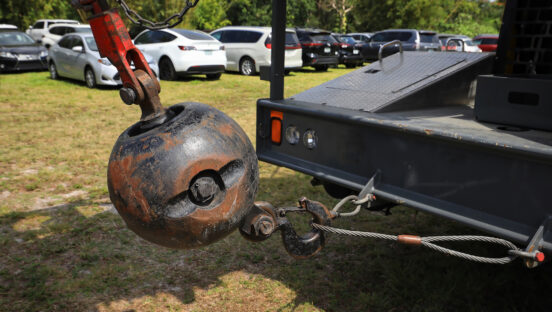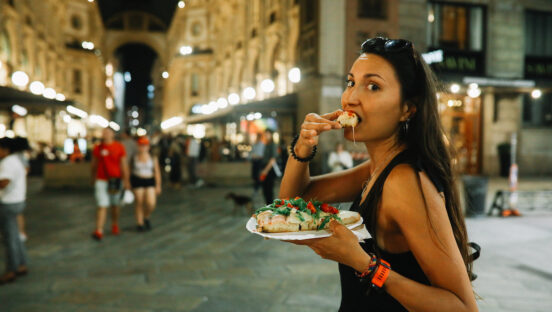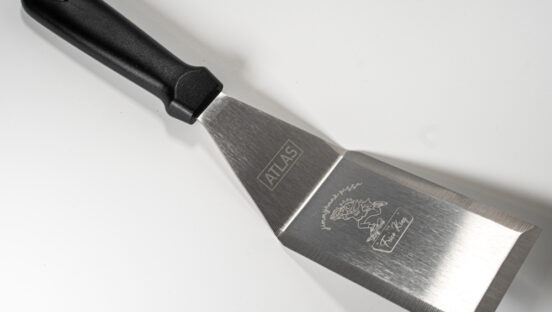In late December, a group of pizza makers embarked on a journey through Latin America to spread the gospel of pizza. The six-week tour included eight cities and seven countries. The venture was hatched by Sofia Arango and her husband and business partner, Alessio Lacco. Together, the duo founded and owns Atlanta Pizza Truck.
Editor’s note: Alessio Lacco and Sofia Arango will both be speakers at the Pizza Power Forum, hosted by PMQ in Atlanta Sept. 4-5. Early-bird registration for the event is now open!
Arango launched the Instagram account Latinos en Pizza about a year ago to shine a light on Latinos in the pizza industry. Did you know that, according to the National Restaurant Association, about one in four members of the U.S. restaurant industry are Latino? Arango was acutely aware of statistics like that one, combined with the fact that Hispanic people do not always get the shine that other pizza makers do.
When the Instagram account caught fire across the U.S. and in the Latin American world—it grew to nearly 10,000 followers in less than a year—Arango and Lacco began wondering if Latinos en Pizza could be something bigger than an Instagram account. Lacco, who is director of the Atlanta chapter of Associazione Verace pizza Napoletana (AVPN), suggested Latinos en Pizza and AVPN team up for a tour of Latin America.
Related: AVPN, Latinos en Pizza Teaming Up To Bring Neapolitan Pizza to Latin America
The trip had two key components: “Pizzaiolo Por Un Dia” (Pizzaiolo For a Day) and “Discovering the True Neapolitan Pizza.” Each was part of a traveling workshop where pizza makers gave tutorials to those who wished to learn about making great pizza. The results were overwhelmingly positive. And, fortunately for PMQ, the details of the trip were recorded journal-style by Arango. This is the first in the series of three installments of Arango’s writing. Each installment will cover a leg of the group’s trip.
JOURNAL ENTRIES LATINOS EN PIZZA (Part 1 of 3)
By Sofia Arango
“Panameño, vida mía, yo quiero que tú me lleves al tambor de la alegría”
El Tambor de la Alegría,
Juan Pastor Paredes, Carmen Lagnon.
Panama City, Panama (December 30-January 4)

As the country that connects North and South America, Panama was the perfect place to begin our journey. Panama’s economy is heavily based on maritime trade and financial services, with a culture strongly influenced by the years when the Panama Canal was under the control of the U.S.
On Dec. 30, we arrived at 3 p.m.; a few hours later, our first class of the Latin America Pizza Tour in collaboration with Emporio Italia and Toro Rosso Pizzeria, would begin. Our sponsors: Gi-Metal, Latteria Sorrentina, and Agriconserva Rega.
We were surprised to be greeted by a full room, with 15 students eager to learn the secrets that our Neapolitan pizza masters had come to share. While Panama is a small country, Neapolitan influence seems to have already begun to take hold on the pizza scene. There are two main reasons for this, we believe.
The first is the strong presence of the Italian community, as Italian citizens have legal advantages due to a friendship treaty between the two nations. The Mutual Friendship, Commerce and Navigation Treaty makes it easier for Italians to obtain permanent residence in Panama. The second is the existence of a famous restaurant chain called Barrio Pizza, which, in its nine years of operation, has been responsible for educating and raising awareness among the public about its flagship product: Neapolitan pizza made with a wood-fired oven.

The humidity and tropical climate in Panama means preparing pizza dough can be a unique challenge. Because the country is so close to the equator, even during wintertime, the country’s temperatures do not drop below 85°F. That means it is imperative to have a refrigerated space to maintain the dough temperature at an optimal point in order to prepare dough with a very low hydration percentage. One must also know how to play with the formula of yeast percentage and fermentation time to find that delicate balance of the perfect dough.
During our time there, Panama became a second home to me—and this is actually more literal than figurative. On January 3, Alessio and I went to pick up our Panamanian permanent residency cards.
I also remember that on the same day, we had scheduled a charity event for the Friends of Children with Leukemia and Cancer Foundation (FANLYC in Spanish) in partnership with a talented local catering company, Pizza Verace.
The event was in the foundation’s courtyard, and that day it was at least 90°F) in the shade, which made cooking pizzas in a 900°F oven a rather exhausting task. However, it was one of the most rewarding experiences we had throughout the tour because it allowed me to explore a facet of our organization that I dream of expanding in our subsequent years of operation, which is helping significantly vulnerable communities on the continent through pizza.
As our motto says, “Let’s change the world, one slice at a time.” That day, I was sure we would achieve it. For now, we had done a lot in the short time we had been there; it was time to move on to the next destination.
“Dios bendiga a Cartagena, la fantástica”
La fantástica,
Carlos Vives.
Cartagena, Columbia (January 4-11)

I want to take a moment to explain how the idea for this tour came about.
Taking advantage of the winter months and the low season for my catering company, my husband, Alessio, and I always travel between January and February. Tired of overcrowded cruises and soulless “All-Inclusive” resorts, we decided we wanted to explore Latin America. This, combined with the birth of my Latinos En Pizza project in April of the previous year, prompted us to organize a trip that would span seven countries and nine different cities on the continent. In addition to vacationing, we would also dedicate ourselves to discovering how the pizza industry worked.
As the director in Atlanta of the Associazione Verace Pizza Napoletana, Alessio decided to share our itinerary with the board of this prestigious institution. AVPN took great interest in the project as it aligned with their expansion plans. The organization specifically shares a desire to expand into Latin America.
So, what had started as a somewhat-excused vacation with a loose work element (it’s very important that my accountant knows this part), turned into what would be our biggest adventure yet: An international tour with 40 days of travel and 13 classes, in which we’d interact with over 300 students.
In sum: It was becoming clear our “vacation” would become total madness. And madness might as well be synonymous with Cartagena, Columbia, which happened to be the next destination on our trip.
I start with this story because, honestly, if we had had to plan this tour solely based on the commercial performance and interest in pizza at each stop, we probably wouldn’t have chosen Cartagena.
It’s no mystery that highly touristic cities constitute a challenging market to navigate due to the constant turnover of people in a short period of time. Culinary offerings tend to focus on a combination of regional dishes and more commercial options, often relegating authenticity and diversity.
Still, I consider Cartagena a must-stop in Colombia. With its cobblestone streets full of history, street vendors, beautiful beaches and a humidity “della Madonna,” as the Italians traveling with me would say, the festive spirit of the city ends up getting into your skin.
During our research, we observed that pizzerias abound on every corner in the city, indicating a clear interest in the product. However, we also noticed a significant lack in terms of the quality of the pizza. With the support of our business allies, we hope to be able to help drive qualitative improvements in Cartagena.
One of those allies is Chef Juan Rodríguez, who, along with his wife, Angelys, showed great interest in supporting our project and promoting culinary excellence in the Cartagena-Barranquilla area.
Under his coordination, we enjoyed an excellent coffee tasting at a local store called Carnaval Café. The tasting gave us a new perspective of Columbian coffee. Additionally, we had the pleasure of being invited to lunch at the Alma restaurant, located in Casa San Agustín, where we had the opportunity to taste typical dishes of the region prepared by the renowned Chef Heberto Eljach, a prominent figure in Cartagena’s culinary scene.

And of course, we couldn’t miss closing the night in a Getsemaní square drinking Colombian aguardiente (“guaro”) at four in the morning. (Special thanks to Anita @anitadelrio.co for the tour and to Alexandra @pizzawithale for the recommendations).
If there’s one thing that characterizes Colombians, it’s their hospitality and friendliness. We are eternally grateful to them for welcoming us with such warmth and showing us their beautiful city. However, after a week, our stop in Cartagena was coming to an end.
In the following days, I would have to part ways with the group due to immigration issues. We were also closing this stop amidst tumultuous news that could jeopardize the continuation of our journey. But more on that in the next entry.
“Mi Quito tiene un sol grande y las noches estrelladas”
Romántico Quito,
Grupo Tradición.
Quito, Ecuador (Jan. 10-14)

Welcome to our first episode of complications, uncertainties and bureaucratic absurdities.
Welcome to the true Latin American experience.
With just two days left before our trip to Quito, Ecuador, we faced the reality that our plans were hanging by a thread. On Jan. 9, an armed conflict erupted in Ecuador. The government faced an uprising from multiple organized crime groups. On the same day, President Daniel Noboa declared a state of emergency and the suspension of constitutional rights throughout the country.
As far as our Latinos en Pizza tour was concerned, the situation was further complicated due to visa issues; I would not be able to enter the country and would have to travel directly to Lima, Peru instead. With the team incomplete, flight itineraries canceled and increasingly alarming news about violence escalating in Ecuador, everything seemed to be working against us. However, our pizzaiolos in Quito were eagerly awaiting us, ready to learn. Giving up was not an option.
So, in the name of love for pizza, we decided the rest of the group should move forward.
What follows next has been extracted from a collection of videos and testimonials obtained from the team members who embarked on the adventure of making pizza in the midst of an internal war outbreak. Thanks to Alessio Lacco, Giancarlo Schiano and Toro Rosso for their excellent memory and willingness to tell the story.
Quito, a city that rises 2,850 meters (9,350 feet) above sea level, has a dry climate with warm days and cool nights. The altitude not only affected the team but also the preparation of dough. The unique climate dictated an increase in the amount of salt used, as well as modified yeast percentages. Several tests were conducted in the days leading up to the class to try to find the perfect recipe.
My sources have also asked me to note that during a tasting of typical Ecuadorian dishes, they unknowingly tried “cuy” meat. For those unfamiliar, the guinea pig, or “cuy,” is a rodent native to the Andes and part of the typical dishes in Ecuadorian, Peruvian and Bolivian cuisine. In other words, the super cute and adorable little animal that any child would wish to have as a pet, turned out to be dinner for Alessio, Giancarlo, and Toro.
But due to the outbreak of war, dough formulation and eating rodents weren’t the only challenges our pizzaiolis confronted. Lacco, Schiano and Rosso witnessed several things on the ground that depicted the volatile nature of Ecuador during their visit. For example, the group witnessed three motorcyclists attempting to ambush a pickup truck in front of them. The truck reversed at full speed and almost hit them, but luckily, the situation didn’t escalate beyond a few minutes of adrenaline.
A day before our first class in Ecuador was scheduled to be held, another inconvenience arose. Due to an explosion in a panel on a Boeing 737 MAX in an Alaska Airlines flight, all planes were grounded until further notice. Since the airline they were traveling with, Copa Airlines, primarily operated such aircraft, there was a massive cancellation of flights that month. While this did not have direct implications for the class in Quito, it complicated the group’s plans to leave Ecuador safely en route to Peru in the coming days.
With only two days to get to Peru and attend the next class—and after hours on the phone trying to contact an operator without success—they decided to go to Copa’s offices to try to find a solution. Unfortunately, they soon learned that, due to Ecuador’s political strife, most people in the city were working from home. They returned to the hotel before the curfew came into effect and rideshare apps went out of service.
Ultimately, they decided to buy a new ticket, at twice the price, with another airline. It wasn’t ideal, but at least we had found a solution.
The day of the class made all the sacrifices worth it. Seventeen students showed up at the headquarters of Equipamiento de Cocina Ecuador. Most of the students were pizzaiolos or pizzeria owners. They commented that these training opportunities rarely took their country into account, and that’s why they were especially excited to be part of this tour. To our sponsors, thank you for making this possible: Gi Metal, Latteria Sorrentina, Agriconserva Rega, Forni Valoriani and Equipamiento de Cocina Ecuador.

However, the group had one last adventure to navigate in order to close the odyssey that was Quito. At the airport, customs officials detained the crew for carrying a suitcase full of t-shirts, books and caps intended for the classes. The problem was eventually resolved amicably by leaving a “gift” to the officials with some of our promotional materials. Alessio asked if they could take a photo with the t-shirt on, but he received a negative. The moment will live only in the memory of those involved.
As they left Quito, everything was back on track. End of the adventure. For now.
Who said a small country was boring?














